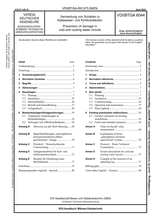Standards Worldwide
Standards Worldwide
Phone +49 30 58885700-07

Technical rule [CURRENT]
VDI/BTGA 6044:2023-04
Prevention of damage in cold and cooling water circuits
- German title
- Vermeidung von Schäden in Kaltwasser- und Kühlkreisläufen
- Publication date
- 2023-04
- Original language
- German, English
- Pages
- 80
- Note
- The publisher recommends this document in lieu of the withdrawn document BTGA 3.003:2017-04; BTGA-Regel 3.003:2017-04 , for which no replacement is available.
- Publication date
- 2023-04
- Original language
- German, English
- Pages
- 80
- Note
- The publisher recommends this document in lieu of the withdrawn document BTGA 3.003:2017-04; BTGA-Regel 3.003:2017-04 , for which no replacement is available.
Product information on this site:
Quick delivery via download or delivery service
Buy securely with a credit card or pay upon receipt of invoice
All transactions are encrypted
Short description
This standard applies to the field of technical building equipment (TGA) within buildings and on sites including for industrial applications for cold and cooling water circuits with a circulating water temperature of below 40 °C. Special features to be observed are described for corrosion-resistant closed cold or cooling water circuits that are operated temporarily or permanently in direct hydraulic connection with hot water heating systems. Increased requirements, such as energy efficiency and cost of systems for cooling buildings and processes, have led in recent years to increasingly complex system configurations with a variety of different materials in the systems. Due to e. g. microbiological processes, unsuitable mixed installations and contamination from production, storage and assembly, operational failures (e. g. due to corrosion damage), efficiency losses and costly repair work can occur. The causes of increased corrosion probability and deposits are often to be found in inadequate preparation and treatment of the filling or make-up and circulating water. During operation, the water quality may change. Therefore, monitoring and documentation of the water quality is necessary. For new plants are discussed:planning from a water engineering point of view; the determination of water parameters of the filling or make-up water as well as of the circulating water in coordination with the used water-contacting materials of the components; flushing after installation during commissioning; the timing and scope of initial and periodic water testing as part of maintenance planning. For existing installations, the following are discussed: the identification of problems and derivation of measures to eliminate the causes of corrosion; problem identification and derivation of measures to eliminate causes of sedimentation; the planning and execution of cleaning measures.
Content
ICS
91.140.10
Also available in
Loading recommended items...
Loading recommended items...
Loading recommended items...
Loading recommended items...
